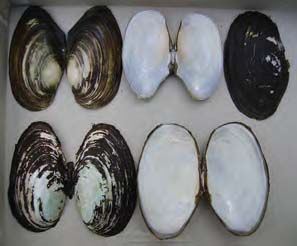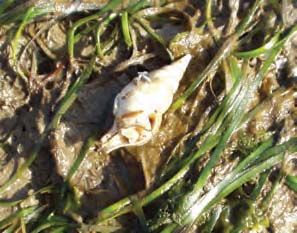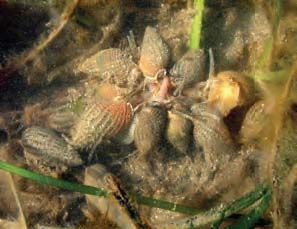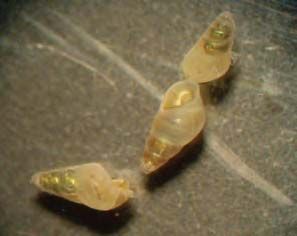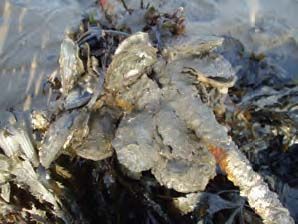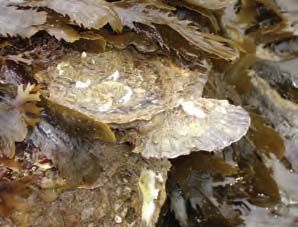|
Considering the type of winter we have had this year, it was a great relief that the weather and tide conditions for this April meeting could not have been better. Although there was some wind, it was sunny throughout the event and the high atmospheric pressure meant that tide levels were lower than expected. There were 12 society members present for most of the events but we were also joined by four other people from time to time making a maximum of 16 people. The society members were:- Dr Julia Nunn, Celia Pain, Ken Hill, Peter Topley, John Llewellyn-Jones, Ron Boyce, Dr Janice Light, Rosemary Hill, Christine Street, Mike Weideli, Ben Rowson and myself. We were joined on some events by three members of the Countryside Council for Wales, namely: - Mr D P Brazier (Intertidal Survey Team Leader), Katherine Birch (Marine Biodiversity Liaison Officer) and Gabrielle Wyn (Intertidal Biologist). Also present was Dr Ivor Rees (formerly of the Marine Sciences Dept at Bangor University). With this eminent team of biologists, the weather, tide conditions and some very interesting shores, we all had a thoroughly enjoyable event. Wednesday 26 April. 1: Newborough Warren – non-marine. Nine members assembled at the car park adjacent to Llyn Rhos-ddu SH426647 for the survey of the warren. Newborough Warren consists of 700 acres of calcareous sand dunes and slacks making it one of the largest in Wales and is situated next to Newborough Forrest to the north, an area of mixed pine of similar size. There are small recent dunes along the southwest shoreline with larger and older dunes inland and separated by slacks (low level wet areas). To the south is the southern entrance to the Menai Straits at Fort Belan where there is a vast area of salt marsh and tidal sand flats. Because of the size and richness of this area and the limited time available before the start of the marine event, we could not do this area justice. Some members of the group divided off to visit salt marshes on the north side of the forest at Malltraeth Sands. In all three non marine and one marine survey was carried out resulting in nine live and two shell non marine records and three live marine records. Of the marine records, one of particular interest was Limapontia depressa found on the salt marsh though not a new record for this area. 2: Traeth Mawr (Aberffraw) – marine. 12 members met for this event at the Aberffraw Dunes car park SH357690, just outside Aberffraw. The normally rich shell bank and shell sand at the mouth of the Afon Ffraw was disappointing as was the case at a number of sites, this is probably due to the exceptionally high tides on the previous tide cycle. However, the group split into two, which resulted in three separate surveys and species lists. Some interesting live species were found such as Rostanga rubra, Caecum glabrum and again Limapontia depressa on a small area of salt marsh at the mouth of the river. Though they were not new records for this area, they were new to me and their discovery was interesting and helpful. There may be three new records for Anglesey from here but they require verification. This site did show an example of how Osilinus lineatus is gaining ground in many areas of southwest Anglesey and the Menai Straits. In 2003, I recorded it as live and common from here, on this occasion it was abundant with many juveniles. Such is the case in many areas and shortly after this event; I found it to be live and occasional between Menai Bridge and Bangor on the mainland side. I have also recently found it as live and rare on the south shore of Great Orme, which is a new record for the Liverpool Bay sea area. Thursday 27 April. 3: Llyn Maelog near Rhosneigr – nonmarine. 12 people met for this site just outside Rhosneigr SH322728. Llyn Maelog is a public access fresh water lake and is popular for anglers. Eight live fresh water species and one live terrestrial species were found here. Along with these was a good collection of perfect pairs of valves of Anodonta anatina and Anodonta cygnea (duck and swan mussels) (Fig 1), which we were told by a local landowner, were live and common in the lake. 4: Rhosneigr – marine. 16 people met in the car park in Rhosneigr SH318730 for this survey. Although the shell sand was again disappointing, this site for me was probably the highlight of the meeting. What would have been the lower shore lake surrounded on all sides by rocks and islands and treacherous when the tide is rising, due to the extra low tide, drained down to just a few inches deep revealing an area of lower shore rapids which, I believe was a rare sight (Fig 2). It was also an excellent opportunity for the group to meet the team from CCW and new contacts have been made as a result of this, it was also a stunning location for all flora and fauna, adult lobsters were walking around our feet. Osilinus lineatus was again live and abundant on the upper shore rocks and there were many interesting live species observed such as Diodora graeca, Elysia viridis, Polycera quadrilineata, Clausinella fasciata, Berthella plumula and Archidoris pseudoargus.
Friday 28 April. 5: Nefyn (Lleyn Peninsula) – marine. 10 people met here on the beach car park SH302407. By now I was very doubtful about finding the normally rich shell sand here. On this flat and very shallow gradient shore of sand and stones, the shell sand does not always accumulate, especially after very high tides. After a brisk look at the upper shore, the tide was still very high at this time, it was decided to abandon this site and try to get shell sand from a more reliable location. A small group went on to Porth Towyn, a small sandy bay several miles further down the Peninsula at SH230375. This is an area which has always provided good shell sand and so it did again. Thanks to Christine’s deliberations two new records for the Anglesey sea area were found, Rissoella opalina and Jordaniella nivosa with a possible third new record to be verified. 6: Porth Dinllaen – marine. 11 people met at the National Trust car park at Morfa Nefyn SH282407 from where we walked along the beach to Porth Dinllaen (Fig 3). The bay at Porth Dinllaen supports an extensive area of eelgrass Zostera marina and was expected to be the highlight of the meeting. The eelgrass was disappointing, the existence of brown algae suggested that the grass was not being grazed. The site did however yield up some interesting observations. Rissoa lilacina was found live on lower shore algae along with one live Arctica islandica and two live Colus gracilis (Fig 4). Large numbers of Hinia reticulata were feeding on dead Ensis (Fig 5) and there were a lot of predated specimens lying around. From sievings of sand close to the Zostera bed, Jan Light retrieved three specimens of an intriguing pyramidellid. The shell most closely resembles Odostomia turrita but the golden colouration of the animal inside is both startling and unfamiliar (Fig 6). Does anyone recognise this snail? Saturday 29 April. 7: Assessment of shell sand and weed washings. Most of Saturday and the previous evenings was spent at my home at Seaspray in Benllech assessing shell sand and weed washings, a particularly enjoyable part of the meeting for me. Five microscopes were set up in the lounge (many thanks to those who brought them along), and the sink was full of weed washings etc. whilst other items were being boiled on the cooker. A neighbour kindly provided a buffet lunch so that we would not have to break off to prepare food, sadly I have no photographs of this. 8: Barras (Menai Strait) – marine. For the final event seven of the group met at Barras on the Menai Strait (Fig 7) SH480655 adjacent to the oyster farming area. Mr Shaugn Krinjen who runs the oyster farm spoke to the group about mussel and oyster farming in the Menai Straits and allowed the group to look round the area where the oysters were being farmed. Various species have been tried in the past, presently Pacific Oysters Crassostrea gigas are being farmed in baskets on trestles at the lower shore where there is a good flow of water (Fig 8). The mussels are farmed about half a mile down the Straits so that they do not choke the oysters and have a turn over of about three years so there is no problem of pearl formation. The oysters Crassostrea gigas grow rapidly in this area due to the flow of water, those that do not grow to a satisfactory size are thrown onto the shore where in many cases, once free of the baskets grow to enormous sizes but are no longer of commercial value. An article from a local paper reports that one of Shaugn’s oysters entered the Guinness Book of Records as the heaviest in Britain at 1.4kg and was around 30 years old. It was here that we saw New Zealand Oysters Tiostrea lutaria (Figs 9 & 10) living wild and abundantly in the Straits. These were introduced some years ago by the Ministry of Agriculture and Fisheries but although they grow faster, larger and bread more profusely than in New Zealand, they were found to be prone to disease and were discontinued. They now occupy several miles of shore in the Straits and are now in parts of the south coast of Anglesey. They attach themselves to any hard substrate they can find even to each other and to shells of Crassostrea gigas and produce beautiful formations and in some areas they are forming reefs. One new record for the Anglesey sea area from here is Ruditapes philippinarum, once farmed here but now living wild. In all, 10 marine and 6 non-marine surveys were carried out and record cards completed though not all species lists have been received. Eight new records for the area have been reported though some need verification. Once all the lists are in and new records verified, a fullillustrated report with species lists will be available for anyone on request if you contact me. I would like to thank everyone who participated in this meeting, for travelling the long distance to Anglesey and helping to make it such an enjoyable event, also a special thanks to Margaret and Bill for providing the buffet lunch. I also thank Mike and Jan for a crash course in learning to use the computer programme Recorder 2002. This now means that I can set to work on computerising the large dataset of mollusc records that I have been compiling since I started marine mollusc recording in 1975. |
Fig 1 Pairs of valves of Anodonta anatina and A. cygnea (Photo Tom Clifton)
Fig 2 Area of lower shore rapids at Rhosneigr (Photo Tom Clifton)
Fig 3 Porth Dinllaen (Photo Tom Clifton)
Fig 4 Colus gracilis (Photo Tom Clifton)
Fig 5 Hinia reticulata feeding on dead Ensis (Photo Tom Clifton)
Fig 6 Odostomia turruta (Photo Peter Topley)
Fig 7 Barras (Photo Tom Clifton)
Fig 8 Crassostrea gigas being farmed at Barras (Photo Tom Clifton)
Fig 9 New Zealand Oysters Tiostrea lutaria (Photo Tom Clifton)
Fig 10 New Zealand Oysters Tiostrea lutaria (Photo Tom Clifton)
|

